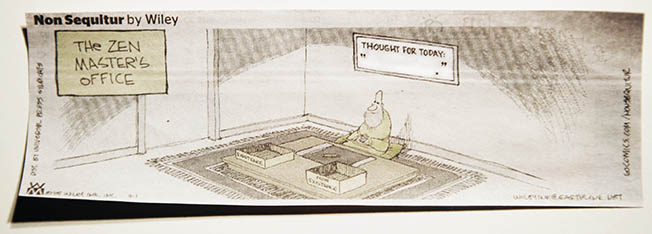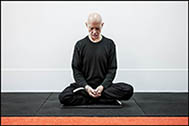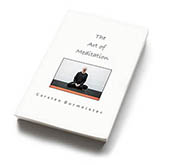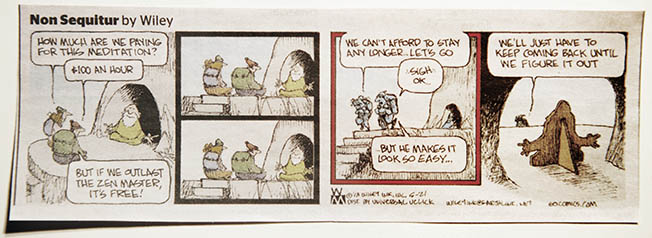
go visit Wiley Miller, check out more non sequiturs

Find out about meditation from Jiddu Krisnamurti, in my blog 477
Krishnamurti:
"Meditation is your daily life without any outside influences. To have that sense of total freedom, to deny everything ... to deny your gods, your sacred books, your traditions, your beliefs, everything wiped away ... which means you are totally independent.
When the mind is totally free from all psychological accumulation, when the mind has become absolutely quiet, that illumination is to see things clearly as they really are … that is meditation"
Osho:
see also my blog 927
"When you are not doing anything at all - bodily, mentally -
when all activity has ceased ... that's what meditation is."
Foreword
Some say meditation is much underrated ... and can't be overrated. My THE ART OF MEDITATION is a how-to guide of my method, which does not follow any traditional meditation regime ... rather it's an accumulation of my own experiences, augmented by thirty years of (informal) studies. The closest to a formal meditation 'technique' in my approach would be that I use Zen principles; for my take on Zen download my ZEN essay.
So what is meditation? Why would one want to meditate? There are two aspects of meditation, (a) it calms and relaxes us, it potentially elevates us above the turmoil of our daily lives ... that primarily is the Western outlook; (b) meditation can be more, where it does the above but then advances us to a loftier goal, that of enlightenment ... this is the Eastern perspective; in THE ART OF MEDITATION I attempt to address both aspects.
Listen to this 10min TED talk on doing Nothing; it is about the Western interpretation of mindfulness meditation, where we mentally step back and the mind - in fact every single thought - is observed ... is witnessed as it comes and goes. This is done in order to apply the notion of 'Living in the Here and Now', the present moment. With my approach to meditation I wish to outline a way of ultimately going further than simply observing the mind.
But what does all this mean on a practical level? When we venture into meditation as beginners, we start with a scattered, restless mind. Our thoughts dart all over the place and we have very little control over them ... if any. This is the first stage in our meditation ... we want to progress from here as quickly as possible. The next stage is mindfulness, when we observe mind and concentrate on the breath; the third stage is to still or empty the mind.
Unity Gym meditation classes were held each month on the first 4 Saturdays at 12:00; register your interest and sign & hand in this disclaimer. In every class I say a few words ... if you join once the course is underway, download the documents with the transcripts of the Course Contents you have missed (I also hand them out at the beginning of every course). If you're unable to join the course, you may wish to buy the course booklet.
In any case, bear in mind that my little The Art of Meditation book contains nothing more than what is on this page; it is little more than a 'souvenir-edition', or indeed a gift you may wish to bestow on a friend. Furthermore, all my writings on meditation are non-copyright, they are open source ... you can use them which ever way you want to (having said that, it would be nice if you linked back to this page for me).

Click here for a printable version of THE ART OF MEDITATION; part 1 is for beginners ... read part 2 after two meditation sessions. For more background information, go to my page THE SCIENCE OF MEDITATION ... please note, my meditation practice differs somewhat from the most popular meditation method, mindfulness meditation. We shall begin with mindfulness and then we see where it takes us and how far you want to go ...
In my book
en.light.en.ment
I have three essays: MEDITATION 1 MEDITATION 2 MEDITATION 3
THE ART OF MEDITATION
The purpose of true meditation is to still or empty the mind; this is arguably the most difficult task there is, hence the practice is more of a journey than a destination. But what is the concept behind the ‘empty mind’? When we analyse the world and assess ‘reality’, we will necessarily form our opinions and beliefs with referencing our very own world-view … and for most of us it's near impossible to see the world from a different view-point than our own. The instrument with which we do this is our mind. In talks and discussions we readily invoke the ‘Power of the Mind’ … which truly is awesome. But the mind has powers that work against us: Mind can create bias and bigotry, fear and disillusionment as well as anxiety, stress, depression and disease. At times - when we want to ‘get real’ about where we stand in the world, where we stood in the past and where we want to go - we want to clear our restless mind and allow ourselves mental inactivity, respite, time-out ... that way we can create space for new ideas, new directions, new undertakings, for potentially calm, clear, unbiased thinking. Indeed, there is scientific evidence this process brings us closer to our goal of inner peace ... meditation is the key to this process.

Part 1 ... how to meditate (the practical part)
1.
meditation is the simplest activity there is: We do nothing when we meditate
2. true meditation is the process of emptying the mind, of not having any thoughts (whatever thought arises we let pass, without getting involved); to achieve this we may use a mantra - any word one is comfortable with - or we use 'Om', ‘Aum’, or ‘Ohmmm’ … not a spoken term but a silent, internal hum; Om is a mantra and considered a mystical Sanskrit sound of Hindu origin, important in Dharmic religions
3.
we can align our breathing with Aum … where we apply it as we slowly breathe out; we breathe in goodness and breathe out the impediments to equanimity: Stress, discomfort, anxiety, nervousness, depression, worry, fear, suffering, tenseness, distress, pain, grief … all accompanied by ‘Ohhhmmmmm …’
4.
we may initially pay attention to our breathing, but ultimately we will leave also this activity behind … we will only return our attention to the breath when we find the mind wandering and getting attached to certain thoughts; remember: Not thinking is the goal of meditation
5.
some meditation methods advise us to concentrate on various body parts or other activities … like our breath; with true meditation these actions are eschewed
6. while the desired outcomes of meditation include a relaxed disposition, meditation in itself is not relaxation; falling asleep while meditating maybe OK in some respects (see point 10) ... but it is a failure as regards the process of true meditation
7.
it is quite possible to meditate lying down or sitting on a chair, but when lying down one may fall asleep, which is to be avoided; when sitting on a chair one may find it hard to stay in a steady position and instead one fidgets and moves around … which can increase nervousness and impatience
8.
one best meditates in the cross-legged position, possibly the half-lotus or even the full-lotus pose, with an erect back … the erect, straight back is most important: One is to find an upright position - preferably without a back-rest - where the body ‘locks-in’ and stays upright without any effort; once this is achieved practitioners do not have to pay attention to their seating position or body posture … to be oblivious to the body is a prerequisite to true meditation: Note ... all yoga exercises were developed to prepare the body for meditation, indeed ... they originally were a meditation; yogis train to achieve a state where they are unaware of the body
9.
nevertheless, the breath-in after the completion of the Aum-accompanied breath-out may be used to adjust our body position … breathe in and stretch the upper body up, to the point where the spine is erect and altogether straight, while the upper torso slightly leans forward, perfectly balanced; this adjustment shall be performed subconsciously and automatically, in fact without thinking about it
10. to begin with we meditate for 20 minutes (it is best to use the timer of a smart phone - such as the iPhone … once it is set its screen will go dark and there is no incentive for us to check the time left until the end of our meditation session) preferably in the morning, adjunct to yoga stretches; ultimately one meditates before bed in the evening too … in fact, an additional lying-down before-sleep meditation can be added to bring the day to a peaceful, restful end; become aware of one important aspect of meditation: Consistency is the key to success ... meditate regularly
11.
for comfort one probably wants to use a meditation cushion; this should have two components, the higher cushion to sit on, a slightly lower part for the legs to rest on … being comfortable during meditation is necessary, otherwise one will not be able to ‘forget’ the body but instead incessantly move around, as one indeed aims to be comfortable
12.
we may close the eyes when meditating, but this is not mandatory; with closed eyes one can visualize scenes - space, water, sky - but one is not to make this an activity; with open eyes one looks at an object in one’s field of view, but again, not concentrate on it … rather let the eyes 'run out of focus’
13.
we shall wear comfortable clothes that do not restrain the body
14.
some may want to play meditation (ambient) music … but this could well be a distraction and probably should be forgone; the argument here could be the soft music cancels out other noise, such as birds singing, wind in the trees or traffic … however, the point is not to concentrate on or even acknowledge any noise; in the beginning of our journey to becoming regular meditators, we may use earplugs
15.
some may wish to burn candles or incense … again, an interference better refrained from; as is concentration on crystals or other trinkets, ikons or ‘holy’ images and texts etc; ‘getting high’ on mind altering substances also is not recommended
16.
group meditation - other than in a learning environment - again holds the potential for distraction … however, there is a social aspect - a community aspect - to group meditation that potentially has a positive effect on the psyche; nevertheless, true meditation is a solitary pursuit
17.
but there is an alternate way of looking at meditation: While once it is a ‘non-activity’, the opposite can be true, where meditation is encapsulated into a benign activity, such as walking or a household chore (washing the dishes), or indeed discharging any duty that does not require thinking … remember, the goal of meditation is to still the mind and this indeed can be achieved while busying oneself in a detached, quiet, acquiescent manner; now meditation has become ‘a way of life’, particularly in the Buddhist Zen tradition; by extension such activities may lead to Mindfulness Meditation (more about this in Part 2). Indeed ... myself, I employ both approaches to meditation; I believe one compliments the other
18. meditation is not a religious activity, though it's spiritual - spiritual as opposed to physical or mental; however, there is nothing mythical or mystical about meditation ... it pertains to reason rather than myth

Part 2 ... mind, ego, lower/higher consciousness, enlightenment (the esoteric part)
19.
the concept of the empty mind, bereft of thought, at the heart of meditation does have a distinct purpose: We strive to empty - or still - the mind in order to (a) avoid - indeed counteract - negative thoughts; (b) to make ourselves aware of the fact that our mind has a monopoly on defining the issues in the forefront of our persona, our ego, our identity … with which we present ourselves to the world
20.
(a) negative thoughts are at the core of all that maligns humanity; every conflict, every war is preceded by negative thinking (… importantly, in this context the opposite of negative thinking actually is not positive thinking, but realistic thinking: Get real)
21.
(b) mind’s function of defining our ego is detrimental when it comes to our inner life … it potentially keeps us from dealing with our inner self, our soul, our inner God; indeed it is the mind that determines and rules our lives … and in meditation we balance this focus with building an introvert, quiet, self-contained world unaffected by the vagaries of the outside world
22.
furthermore, our mind (through our ego) sets up the barriers that prevent us from dealing with our emotions … ‘it’s all in the mind,’ goes the cliché
23.
our emotions to a large degree are ruled by occurrences in our past, which have trapped us, but which we fail to deal with on a thought- or mind-level, since we may perceive them to be too painful and thus decide to ignore them
24.
then bypassing the mind is probably the only way to access those emotions, to delve into our inner self ... as we disconnect from our outer self
25.
a precursor to meditation is contemplation: Before one engages in true meditation (when one dis-continues thinking) there naturally are a few moments of contemplation, where one ponders the issues that mind creates to define our life … this period shall be dealt with swiftly
26.
contemplation shall resume after meditation, once the mind has rested and is able to deal with life-defining issues in a fresh and constructive manner … indeed by throwing ‘a new light’ on issues that before were in the ‘too hard basket’
27.
our ego is the outer person as we want to be seen by the world … it is the aspect of ourselves that makes our life’s determinations, for better or worse
28.
it is our ego (… ruled by the mind) that prioritizes our ambitions, desires and actions … actions that often are selfish, but which we perceive as necessary to advance us in the jungle we call life
29.
hence our ‘fight for survival’ … the fight that may lead us to be unsympathetic to the needs of our neighbour; that disables our switch to compassion, tolerance, kindness, charity and sympathy … simply put: That suppresses our humanity
30.
thus our mind can be seen as the source of unethical behaviour, indeed, as the source of evil ... only our mind has the potential to be evil, evil doesn't exist anywhere else; nature is never evil, even with its earthquakes, floods, bushfires, man-eating sharks … it is mind alone that has the capacity for evil
31.
at this point we recognize the mind as a dualistic entity: On one level the ordinary mind acts out and guides our worldly activities … while the refined mind connects us with our inner self, our soul
32.
put simply: Ordinary mind = ego (our ability to act, judge, debate, rationalise, build, destroy, lie and cheat) … refined mind = soul (our capacity for love, compassion, truth, tolerance and charity)
33.
thus when we meditate and bypass the ordinary mind (or lower consciousness) and as we activate the refined mind (or higher consciousness), we refrain from letting negative, immoral, unethical - indeed evil - thoughts arise … and we lay the foundation for a better world
34.
meditation induces in us the notion there is more than what our (ordinary) mind comprehends; a new path opens up for us to follow, one that leads to our inner life, unobstructed by a fickle ordinary mind; then we become attuned to our higher consciousness beyond negative thinking and engage in - what in the Buddhist tradition is called - mindfulness
35.
this is a path replete with fulfilment and the knowledge that - in a spiritual sense - nothing is important ... we may think (rather our ordinary mind thinks) we have certain worldly needs, yet our heart (our soul, our refined mind) knows that - to use a cliché - ‘there are more important things in life’
36.
we learn that our inner, emotional life is the only truly important reality; everything else is out of our control … and since we cannot control the circumstances in our life (the only control we have is how we deal with those circumstances) we may as well deal with what we can control: Our emotional wellbeing
37.
then what our mind dictates to us is relegated lesser importance than what our heart wants us to express … the love that is inherent in all of us; the love for fellow humans (this is the noblest goal in life: To become aware of - and to live by - the Truth … all humans are equal and our love for humanity is paramount) accompanied by the love for our family: Our parents, children, partners
38.
when we thus are aligned with our inner life we prioritize differently: Now worldly goods and achievements are allocated their proper level of importance; that brand new (too expensive) car is much less desirable; the larger (too large) house loses its attractiveness; the all-important (but stressful) promotion turns out not all that important anymore; even the mind-numbing annoyance we experience when dealing with irritating people becomes insignificant … in the grand scheme of things, so to speak
39.
but of course this doesn't mean we shall become reckless in our dealings with the world ... in the contrary, as we allocate realistic priorities to our worldly exploits (as we ‘get real’), we learn to be shrewd and clever with the commercial affairs we have to look after for our and our family's wellbeing ...
40. ... and we gain strength from renouncing the excesses that may prevent us from dealing with our inner life; we now are on the path to a stressless, peaceful, satisfactory and fulfilled existence
41. in this spirit it is reasonable to say meditation not only has the potential to inspire us to adapt tolerance, understanding, temperance, forebearance and charity in our personal life ... but these concepts affect issues and outcomes on the world stage: Leaders imbued with higher consciousness are inclined to the view that nothing is worth war: Not border disputes, not clashes over ownership of resources, not the perceived superiority of some races, tribes, ethnic and religious groups or nations
42. those who act from their higher consciousness are on the way to enlightenment ... this is the ultimate goal of meditation
.
